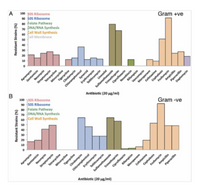
Human Anatomy & Physiology (11th Edition)
11th Edition
ISBN: 9780134580999
Author: Elaine N. Marieb, Katja N. Hoehn
Publisher: PEARSON
expand_more
expand_more
format_list_bulleted
Concept explainers
Question
thumb_up100%
Based off of the graphs, answer these questions:

Transcribed Image Text:10. From what other environments might scientists collect bacterial samples to further test their hypothesis that
antibiotic resistance is a trait that evolved without being influenced by modern antibiotic use?
11. What precautions might need to be taken by the scientists who work with these bacteria in the lab?
12. How many of the 26 antibiotics successfully killed 100% of the bacterial strains (both Gram-positive and Gram-
negative)?
13. What does this make you think about our ability to fight infections with our current arsenal of antibiotics?
14. Do the results of this study give us any insights into how we might combat antibiotic resistance going forward?
If so, what?

Transcribed Image Text:A
100 3oS Ribosome
90 5oS Ribosome
Folate Pathway
0 DNA/RNA Synthesis
Cell Wall Synthesis
Cell Membrane
Gram +ve
Streptomycin
B
Clindamycin
100 130S Ribosome
90 5oS Ribosome
80 Folate Pathway
70 DNA/RNA Synthesis
60 Cell Wall Synthesis
Erythromycin
Telithromycin
Linesolid
Chloramphenicol
Sulfamethoxasole
Antibiotic (20 pg/mi)
50
40
Gram -ve
Apramycin
Gentamicin
Tetracycline
Chloramphenice
Telith
Clindamycin
romycin
hoxasol
Sultamet
Antibiotic (20 vg/mi)
Trimethoprim
Rifampic
Me
Fosfomycin
() sujeas
Resistant
Apramycin
Gentamicin
(%)
tracycline
inocycline
Tigerycline
nt Strains
Resista
Streptomycin
uka
Ampicilin
Piperacilin
Daptomycin
Ciprofloxacin
Cephalexin
Ampicillin
Expert Solution
This question has been solved!
Explore an expertly crafted, step-by-step solution for a thorough understanding of key concepts.
This is a popular solution
Trending nowThis is a popular solution!
Step by stepSolved in 5 steps

Knowledge Booster
Learn more about
Need a deep-dive on the concept behind this application? Look no further. Learn more about this topic, biology and related others by exploring similar questions and additional content below.Similar questions
- Indicate on diagram where ASD would occurarrow_forwardA GWAS is done comparing squirrels with spots to those without. Answer the following questions about the plot shown. (A) What type of plot is shown? (B) What does each dot represent? (C) How are the dots arranged along the X and Y axis? (in other words, what determines where a dot is placed on the graph?) -log10(pvalue) 25- 20- 15- 10- 5- 0 -10 5 10arrow_forwardWhich one inconsistently affect measurent? Random or systematicarrow_forward
- Which statistical calculation would be used to study the range of variation that is present in a set of data values? A B с D standard error mean average standard deviationarrow_forwardHow do I create a bar graph using the hardy Weinberg data provided but in the bar graph format on the right ?arrow_forwardWhat is the molecular level of shingles? Break it down when explaining at least a paragraph. cite credible sources, pleasearrow_forward
- plants were grown using two differenc fertilizers and the number of flowers that each plant produced was counted. to test for a significant effect of fertilizer on the number of flowers at the 5% level significance, the calculated and the critical values were computed. type both the null and the alternative hypothesis for this test in the box below. use full sentences to describe both H0 and H1. (no mathematical terms in the answer)arrow_forwardPlease Asaparrow_forward
arrow_back_ios
arrow_forward_ios
Recommended textbooks for you
 Human Anatomy & Physiology (11th Edition)BiologyISBN:9780134580999Author:Elaine N. Marieb, Katja N. HoehnPublisher:PEARSON
Human Anatomy & Physiology (11th Edition)BiologyISBN:9780134580999Author:Elaine N. Marieb, Katja N. HoehnPublisher:PEARSON Biology 2eBiologyISBN:9781947172517Author:Matthew Douglas, Jung Choi, Mary Ann ClarkPublisher:OpenStax
Biology 2eBiologyISBN:9781947172517Author:Matthew Douglas, Jung Choi, Mary Ann ClarkPublisher:OpenStax Anatomy & PhysiologyBiologyISBN:9781259398629Author:McKinley, Michael P., O'loughlin, Valerie Dean, Bidle, Theresa StouterPublisher:Mcgraw Hill Education,
Anatomy & PhysiologyBiologyISBN:9781259398629Author:McKinley, Michael P., O'loughlin, Valerie Dean, Bidle, Theresa StouterPublisher:Mcgraw Hill Education, Molecular Biology of the Cell (Sixth Edition)BiologyISBN:9780815344322Author:Bruce Alberts, Alexander D. Johnson, Julian Lewis, David Morgan, Martin Raff, Keith Roberts, Peter WalterPublisher:W. W. Norton & Company
Molecular Biology of the Cell (Sixth Edition)BiologyISBN:9780815344322Author:Bruce Alberts, Alexander D. Johnson, Julian Lewis, David Morgan, Martin Raff, Keith Roberts, Peter WalterPublisher:W. W. Norton & Company Laboratory Manual For Human Anatomy & PhysiologyBiologyISBN:9781260159363Author:Martin, Terry R., Prentice-craver, CynthiaPublisher:McGraw-Hill Publishing Co.
Laboratory Manual For Human Anatomy & PhysiologyBiologyISBN:9781260159363Author:Martin, Terry R., Prentice-craver, CynthiaPublisher:McGraw-Hill Publishing Co. Inquiry Into Life (16th Edition)BiologyISBN:9781260231700Author:Sylvia S. Mader, Michael WindelspechtPublisher:McGraw Hill Education
Inquiry Into Life (16th Edition)BiologyISBN:9781260231700Author:Sylvia S. Mader, Michael WindelspechtPublisher:McGraw Hill Education

Human Anatomy & Physiology (11th Edition)
Biology
ISBN:9780134580999
Author:Elaine N. Marieb, Katja N. Hoehn
Publisher:PEARSON

Biology 2e
Biology
ISBN:9781947172517
Author:Matthew Douglas, Jung Choi, Mary Ann Clark
Publisher:OpenStax

Anatomy & Physiology
Biology
ISBN:9781259398629
Author:McKinley, Michael P., O'loughlin, Valerie Dean, Bidle, Theresa Stouter
Publisher:Mcgraw Hill Education,

Molecular Biology of the Cell (Sixth Edition)
Biology
ISBN:9780815344322
Author:Bruce Alberts, Alexander D. Johnson, Julian Lewis, David Morgan, Martin Raff, Keith Roberts, Peter Walter
Publisher:W. W. Norton & Company

Laboratory Manual For Human Anatomy & Physiology
Biology
ISBN:9781260159363
Author:Martin, Terry R., Prentice-craver, Cynthia
Publisher:McGraw-Hill Publishing Co.

Inquiry Into Life (16th Edition)
Biology
ISBN:9781260231700
Author:Sylvia S. Mader, Michael Windelspecht
Publisher:McGraw Hill Education